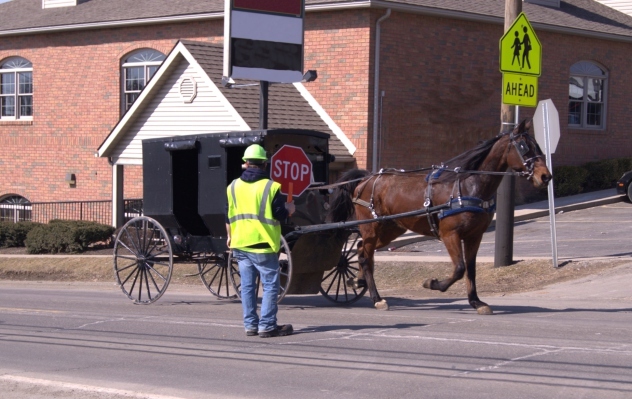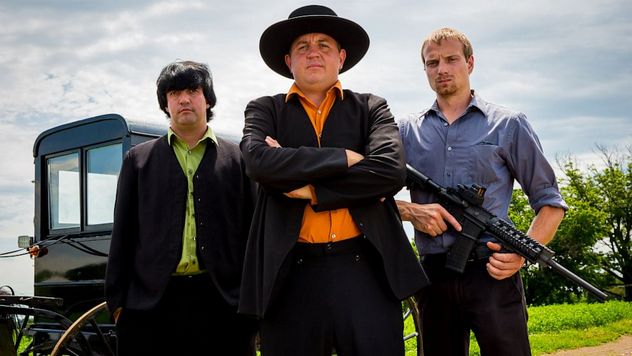 Movies and TV
Movies and TV  Movies and TV
Movies and TV  History
History 10 Things You Didn’t Know About the American National Anthem
 Technology
Technology Top 10 Everyday Tech Buzzwords That Hide a Darker Past
 Humans
Humans 10 Everyday Human Behaviors That Are Actually Survival Instincts
 Animals
Animals 10 Animals That Humiliated and Harmed Historical Leaders
 History
History 10 Most Influential Protests in Modern History
 Creepy
Creepy 10 More Representations of Death from Myth, Legend, and Folktale
 Technology
Technology 10 Scientific Breakthroughs of 2025 That’ll Change Everything
 Our World
Our World 10 Ways Icelandic Culture Makes Other Countries Look Boring
 Misconceptions
Misconceptions 10 Common Misconceptions About the Victorian Era
 Movies and TV
Movies and TV The 10 Coolest Stars to Set Sail on The Love Boat
 History
History 10 Things You Didn’t Know About the American National Anthem
 Technology
Technology Top 10 Everyday Tech Buzzwords That Hide a Darker Past
Who's Behind Listverse?

Jamie Frater
Head Editor
Jamie founded Listverse due to an insatiable desire to share fascinating, obscure, and bizarre facts. He has been a guest speaker on numerous national radio and television stations and is a five time published author.
More About Us Humans
Humans 10 Everyday Human Behaviors That Are Actually Survival Instincts
 Animals
Animals 10 Animals That Humiliated and Harmed Historical Leaders
 History
History 10 Most Influential Protests in Modern History
 Creepy
Creepy 10 More Representations of Death from Myth, Legend, and Folktale
 Technology
Technology 10 Scientific Breakthroughs of 2025 That’ll Change Everything
 Our World
Our World 10 Ways Icelandic Culture Makes Other Countries Look Boring
 Misconceptions
Misconceptions 10 Common Misconceptions About the Victorian Era
10 Weird Facts About The Amish
We’ve already addressed the Amish quite thoroughly, but there is far more to say about this group of people who eschew modern conventions and wake at the crack of dawn.
10Mini-Me

Overall, the Amish are an exceedingly healthy group of people. They lead simple, agrarian lives with a high level of physical activity and diets free of preservatives and junk food. Unlike other members of modern society, they suffer a fraction of the stress of those stuck in the so-called rat race. But as an extremely insular community, the Amish have a very shallow gene pool. The population of around 250,000 hails from roughly 200 families, leading to an issue called “founder effect,” which results in a laundry list of congenital disorders and a staggering infant mortality rate. Some of their diseases are so vanishingly rare that the medical community hasn’t even given them names yet.
Given their private nature, the general public has rarely had the opportunity to witness the disorders ravaging the Amish. However, at least one man born Amish has risen to worldwide stardom, all on the shoulders of his congenital disability. Actor Verne Troyer is one of the shortest men in the world. He stands at just 81 centimeters (2’8″) tall, shorter than the average three-year-old child. Troyer is a cultural phenomenon, due to his role as “Mini-Me” from the Austin Powers franchise. Troyer suffers from a genetic disorder called cartilage-hair hypoplasia. Despite his tiny stature, Verne was never treated with kid gloves by his family. According to Verne, they “never treated me any different than my other average sized siblings. I used to have to carry wood, feed the cows and pigs and farm animals.”
9The Amish Computer

The Amish have a long tradition of shunning modern technology, hence their reliance on horse-and-buggy transportation. However, every community makes its own rules, and many invent clever loopholes to enjoy conveniences. The Amish do not have phones in their homes, but there is typically a phone booth available in the community. Likewise, they do not own cars but will accept rides from others or occasionally hire a taxi. It is also somewhat inaccurate to say that they do not have electricity in their homes. While their houses are not connected to power grids, many have gas-powered generators to operate appliances like refrigerators and water heaters.
One of the strangest concessions they have made is adopting computers. The Deskmate is a computer that is specifically marketed toward the Amish. The device is decidedly no-frills—it does not connect to the Internet, play videos, or have any games. It is designed exclusively for business purposes, with word processing, accounting, and spreadsheet programs.
8Homicide
One of the central tenets of the Amish faith is nonviolence. They are a largely peaceful group, so much so that there has only ever been one man convicted of homicide in their history. Edward Gingerich never really fit in with the rest of the Amish community. The Pennsylvania native exhibited signs of mental illness from a young age. After getting married to a woman named Katie and starting a family, his mental state grew increasingly worse. He began consorting with outsiders, including a born-again Christian named Dave Lindsey, who convinced Gingerich he would go to Hell if he didn’t leave the Amish community. Eventually, Gingerich had a psychotic episode complete with hallucinations, and 911 was called.
It was determined that Gingerich suffered from paranoid schizophrenia, and he was provided medication to manage the symptoms. However, he didn’t like the side effects of the drugs and stopped taking them. The madness reached a head on March 18, 1993, when Gingerich savagely attacked Katie in the kitchen of their home. Their son ran to his uncle’s house for help, but it was far too late. Gingerich stomped Katie’s skull in with a boot, then ripped out her internal organs, piling them next to the body.
Because of his mental illness, Gingerich only served five years behind bars. In 2011, he hanged himself, leaving a message that read “Forgive me please.”
7Rape

While murder might be practically unheard of in Amish communities, other crimes are sadly prevalent. The Amish operate a patriarchal society, and sexual abuse has been known to occur, including incest and pedophilia. For all intents and purposes, it is impossible to tell how bad the problem is, because it is handled within the community. The punishment for confessing to rape isn’t particularly draconian either— the rapist is banned from church activities for six weeks, until he shows that he is genuinely sorry. The Amish are more concerned with the person being honest about what he has done than with the actual crime itself. Bizarrely, the same punishment is leveled for drinking to excess.
In the few rare instances where mere excommunication doesn’t work, the community turns to external law enforcement, such as in the case of Chester Mast. Mast was excommunicated three times for the rape of his younger cousins before he was finally reported and arrested. Even in this horrendous case, some members of the church continued to stand by Mast and visit him in prison for spiritual counseling.
6Horse-And-Buggy DWIs

The most obvious trapping of the Amish culture is their horse and buggy. This is a very basic form of transportation but not without certain modern amenities. The law dictates that buggies must be outfitted with turning signals and headlights, and some Amish have installed things like windshield wipers and interior dome lights. For the tech-savvy, Pennsylvania has published a driver’s manual, which teaches the rules of the road and stresses courtesy for drivers of automobiles.
In the eyes of the law, the horse and buggy is seen as a vehicle, and one can be arrested for driving one while intoxicated. This is a rare occurrence but certainly not unheard of. In 2009, 22-year-old Elmer Stoltzfoos Fisher was taken into custody after he was found sleeping in a buggy in Pennsylvania. In 2011, reckless 17-year old Lewis Hostetler even led police in upstate New York on a chase after he was pulled over for drinking a beer.
5The Amish Madoff

The Amish might be extremely religious, but they have hardly taken a vow of poverty. Indeed, they tend to be very good businessmen, willing to work extremely hard to make their ventures succeed. And where there is money, corruption is soon to follow, even among people so dedicated to God. Indeed, the Amish have their very own version of Bernie Madoff—Monroe Beachy of Ohio, an investment broker who lost an estimated $16.8 million of his clients’ money on risky stocks. While the investments were disappearing, Beachy lied to the clients and assured them their money was safe.
When Beachy was caught in the fraud scheme, the Amish beseeched US District Judge Benita Pearson to release him and allow them to resolve the issue within their own community as is their wont. The defense lawyer also argued that Beachy had never stolen any of the money for himself and deserved a milder sentence. However, Pearson rejected their claims, telling the 78-year-old swindler “You must be punished for what you did under federal guidelines. There can be no carve-out because you belong to a religious community that I respect.” In 2012, Beachy was sentenced to six and a half years in prison for his crimes.
4Faceless Dolls

Most little kids play with dolls at one point or another, and Amish kids are no exception. However, their dolls are a little different than those owned by other children. Their handmade rag dolls, dressed in Amish attire, typically do not have faces. Exactly why this is the case is up for debate, but it would seem to be in line with the Amish belief that humans should not make graven images and that only God can make people. A faceless doll indicates that all children are the same in God’s eyes. Both boy and girl dolls exist, dressed in elaborate outfits.
These dolls can be a bit disconcerting to outsiders, as some cultures feature faceless monsters, such as Japan’s Noppera-bo. However, they are often sold to tourists as souvenirs, and antique dolls can be collectible and very expensive.
3Puppy Mills
Animal welfare agencies have long advised the public against buying puppies at pet stores, instead promoting rescue pets or responsible breeders. The dogs sold in pet stores typically come from “puppy mills,” wretched institutions where animals are crowded into rabbit hutches and made to breed. When the dogs are of no use, they are euthanized. The animals are often sickly and covered in filth, their vocal cords damaged to prevent them from barking. Surprisingly, the Amish operate many such establishments. Lancaster County, Pennsylvania has been called “the puppy mill capital of America.” In Ohio, another state with a large Amish population, there are dog auctions where middlemen can buy puppies and then flip them for a profit.
Unlike dog fighters, who often behave sadistically toward the animals, the Amish have no intention of being cruel to the dogs. They merely view them as livestock, no different than a pig or a chicken that might end up on a dinner plate.
2Reality TV

Reality shows tend to focus on the rich and glamorous, lending us a glimpse of the kind of fantasy lives most of us will never lead. The Kardashians and The Real Housewives aside, one of the more recent focuses of these shows have been the Amish. TLC ran two seasons of a show called Breaking Amish, which featured young Amish people experiencing outside culture and making the difficult decision on whether to join modern society or return to their roots. Among the cast members was Kate Stoltzfus, who left the faith to become a model, appearing in Maxim magazine.
The most controversial of these shows is no doubt Discovery Channel’s Amish Mafia, which centers around a shady character named Lebanon Levi and his cohorts in Lancaster, Pennsylvania. Levi deals with issues inside the community and fosters relations with the outside world. Even the least skeptical viewer can see that most of this show, with “dramatic re-enactments” is completely fake, yet it is popular enough to have been renewed for a fourth season. Several Pennsylvania politicians, including Governor Tom Corbett, have signed a document calling for the end of the show’s production, calling it “religious bigotry.”
1Exploding Population

Reality TV shows and the wild rite of Rumspringa might have you convinced that the average Amish youth is just itching to escape their mundane life of chores and church services. But the Amish lifestyle is hardly on the wane—their population is actually growing by leaps and bounds each year. At the beginning of the 20th century, there were only about 5,000 Amish. Today, they number at least 250,000. It is estimated that their population doubles once a generation.
Although the Amish don’t evangelize or attempt to recruit like some other religious groups, they do get a rare convert here or there. However, the vast majority of the population explosion is natural growth. The Amish tend to have very large families, averaging six or seven children. Most of these do not leave the community but rather begin families of their own. Leaving the community has serious consequences—the Amish tend to shun those who move on, and the fear of never again speaking to family members keeps the youth from seeking a more convenient lifestyle.
Mike Devlin is an aspiring novelist.








